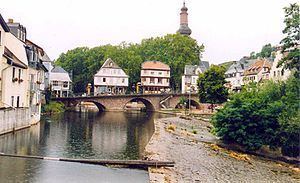Unknown Carlos Coloma Date 9 September 1620 Location Bad Kreuznach, Germany | All forces surrendered None Result Spanish victory | |
 | ||
3 infantry companies
1 company of cavalry
(Exact number unknown) 5,000 infantry
300 cavalry
4 cannons | ||
Siege of bad kreuznach
The Siege of Bad Kreuznach or the Spanish capture of Bad Kreuznach took place on 9 September 1620, in Kreuznach, Electorate of the Palatinate, between the Spanish forces of Don Ambrosio Spinola, commanded by Don Carlos Coloma de Saa, 1st Marquess of Espinar against the forces of the Electorate of the Palatinate during the Palatinate campaign, in the context of the Thirty Years' War. The Spanish troops stormed the city and obtained the surrender of the garrison. Later the town was released on a promise not to fight back against the Holy Roman Empire.
Contents
Background
The Thirty Years' War began in 1618 with the Bohemian Revolt, when the authorities of this kingdom offered their throne to the Protestant Frederick V of the Palatinate, who accepted, initiating a conflict between the Protestant Union led by Frederick and the House of Habsburg. Two years after the outbreak of the war the situation had apparently stalled, but in reality the Habsburgs through its diplomatic maneuvers were able to isolate politically to Frederick, between whose hits highlighted Spain's entry into the conflict.
Under the agreement with the Emperor, in August 1620, Don Ambrosio Spinola, commander of the Spanish army, crossed the Rhine at the head of an army of 22,000 men and invaded the Lower Palatinate. Since the Elector Palatine had not yet begun hostilities against the Spanish Monarchy, Spinola decided to proceed to occupy, peacefully if it was possible, the main towns of his state. On 8 September Spinola marched with his army against the Palatine forces not far from Oppenheim. At midnight ordered to his Field Master Don Carlos Coloma, Governor of Cambrai, taking the town of Kreuznach, in command of two Tercios of infantry, numbering about 5,000 soldiers and 300 horsemen, a town of some importance because it had a bridge over the Rhine protected by walls on both sides of the river and a castle.
Assault
Don Carlos Coloma arrived with his troops at the gates of the town on the evening, 10 September, and sent emissaries to the authorities saying that if they surrendered to the obedience of Emperor Ferdinand II would be well treated. Faced with an ambiguous response from the defenders, Coloma ordered to place the 4 cannons he had, and moved his troops to the foot of the walls, and the gate of the town to launch the assault.
The defenders of Kreuznach, whose forces consisted of three companies of infantry and one of cavalry, decided to act and fired their muskets from the castle overlooking the town. Then, the Spanish, in perfect formation, responded by opening fire with their cannons. Few minutes after, the garrison decided to surrender the town. The Spanish troops captured the horses and the weapons of the Palatine soldiers, and Coloma forced the Palatine troops to take an oath not to fight anymore against the Emperor.
Consequences
With the news of the fall of Kreuznach, Spinola continued the march with his army over the Palatinate to Alsheim, one of the main cities of the region, and captured it in the same day. Four days after, on 14 September, Spinola, with a great maneuver of distraction over Worms, captured Oppenheim, without too much difficulty, causing a severe blow to the Protestant forces.
